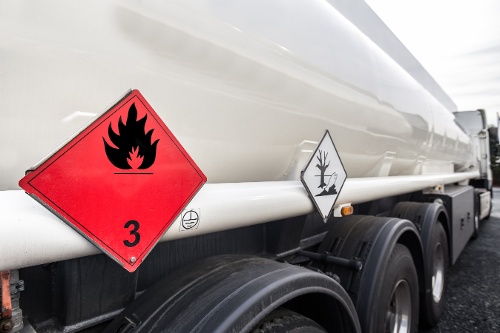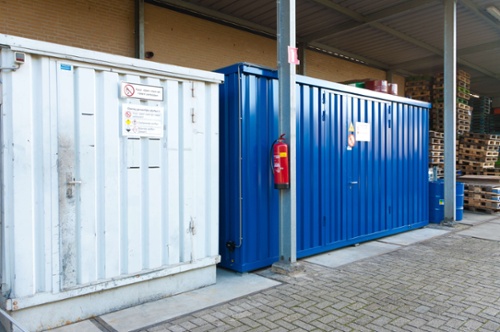When you’re working with flammable liquids, understanding the physical and chemical properties of the substance is an important first step in providing the right risk control measures. Along with the chemical’s flash point and auto-ignition temperature, the explosive limits of the substance should be fully understood so incidents such as a workplace explosion can be prevented. But what are the explosive limits of a substance and how should they be managed? In this blog, we’ll be looking at the explosive limits of flammable liquids and explaining how you can control the risk of explosions in your own workplace.
Defining Explosive Limits
But first, let’s explain what is meant when we refer to the explosive limits of a chemical. Explosive limits are also known as the ‘flammable limits’ of a substance. The explosive limits refer to the concentration of a gas or vapour in the air which will result in an explosion – if an ignition source is present.
IMPORTANT: Your chemical product’s Safety Data Sheet (SDS) will feature the explosive limits of your substance in Section 9. Physical and chemical properties. Always refer to each SDS of your individual chemical products to determine the lower and upper explosion limits of your workplace chemicals.
Upper and Lower Explosive Limits
The explosive limits are detailed as a lower limit and an upper limit — which are both listed as a percentage. The lower explosive limit, or LEL, is the lowest possible concentration of a gas or vapour in the air which will burn or explode if ignited. The upper explosive limit, or UEL, is the highest possible concentration of a gas or vapour in the air which will burn or explode if ignited. Within these two listed limits is the concentration levels of gas or vapours which will cause a substance to explode.

The explosive limits of flammable liquids, such as petrol, are the range in which enough vapour or gas is present to burn or explode.
For example, an unleaded petrol may have a lower explosive limit of 1.4% and an upper explosive limit of 7.6%. Acetone may have an LEL of 2% and a UEL of 13%. Ethanol may have an LEL of 2.5% with an UEL of 13.5%. Whatever substance you’re working with, it’s important that you study the Safety Data Sheet to find all the physical and chemical properties of the substance, including the explosive or flammability limits.
Understanding The Properties Of Flammable Liquids
When discussing the explosive limits of a flammable liquid, you should not confuse this with the chemical’s flashpoint. The flashpoint is the temperature at which a flammable liquid produces sufficient flammable vapours to ignite — in the presence of an ignition source. Most flammable liquids have low flashpoints, which means that they can produce enough flammable vapours in regular work settings that may cause a fire if the vapours come near an ignition source. This low flashpoint — and the ability to ignite at normal working temperatures — is why flammable liquids are recognised as a dangerous and volatile substance.

Any type of ignition source should be properly identified and isolated in workplaces that carry Class 3 Flammable Liquids.
Auto-ignition temperatures are another physical and chemical property which should not be mistaken for the explosive limits of a substance. The auto-ignition temperature of a flammable liquid is the lowest ambient temperature at which the flammable liquid will spontaneously combust — without an ignition source having to be present.
When handling or storing Class 3 Flammable Liquids, all staff and contractors must be aware of the flashpoint and auto-ignition temperatures. They should also be made aware of the explosive limits of the substance, so that flammable vapour emissions are adequately monitored and maintained. While auto-ignition temperatures don’t require a source of ignition to create an explosion, both the flashpoint and the explosive limits of a substance indicate the state at which the chemical will burn or explode if an ignition source is introduced.
Therefore, the identification and control of ignition sources is crucial in maintaining a safe working environment for companies which carry and store Class 3 Flammable Liquids.
Controlling Flammable Vapours and Gases
When you note the explosive limits for your products, understand that the limits are the range in which a chemical can produce an explosion in the presence of an ignition source. Any concentration levels that fall below the LEL are considered safe, while concentration levels above the UEL are too rich to burn.
However, that’s not to say that concentrations of vapours or gases over the UEL are safe — in fact, high concentrations of hazardous or flammable vapours are prohibited in Australia through Safe Work Australia’s workplace exposure limits.
How To Manage Risk
When we’re talking about any type of hazardous chemical or dangerous goods, there are two types of hazards that must be controlled. These are the health hazards, which relates to the properties of the chemical and how it can affect human health, and the physical hazards, which are the properties of the chemical which can produce damage to property or injury to people.
Flammable liquids pose health and physical hazards to the organisations that carry them. However, risks can be reduced by educating workplaces on the safest ways to handle and store these volatile chemicals.
You must keep flammable liquids vapour concentrations within safe levels for many reasons including:
- Human health – high concentrations of vapours in the breathing area of workers can lead to acute and chronic health issues, and fatalities
- Ignition – if your flammable vapour concentrations are high, it will increase the risk of a flashback or fire occurring in the presence of an ignition source
- Explosion – your vapour concentrations must stay below the explosive limits due to the risk of an explosion occurring in the presence of an ignition source
Storing and Handling Flammable Liquids
When considering the explosive limits of flammable liquids, you must consider the environment in which you handle and store your chemicals. Due to the substance’s ability to ignite, auto-ignite and explode, flammable liquids must have a range of control measures in place to keep the working environment safe.
Controlling the risk of ignition, fire and explosion can be through a series of methods including:
- Chemical hazard awareness – properly placarding all chemical storage and handling areas, so staff are aware of the potential hazards
- Flammable liquids safety – only allowing properly trained staff and contractors to handle or transfer flammable liquids
- Compliant storage areas – ensuring flammable liquids are stored in an environment which does not pose a risk of ignition or explosion
- Safe handling practices – making sure that all staff follow the correct procedures when decanting, pumping, transferring, using or otherwise handling the flammable liquids
- Reviewing control measures – creating a system of monitoring and adjusting any control measures to ensure that they remain compliant and effective
We’ll now take a closer look at how you can reduce risk through controls such as ventilation, bunded storage, safe chemical transfer and housekeeping practices.
Ventilation
As we’ve highlighted in this blog, high concentrations of hazardous vapours can have disastrous consequences for organisations that carry flammable liquids. If flammable liquids are not handled and stored correctly, large concentrations of vapours can be emitted from the chemicals — posing risk to people and property.
Maintaining a safe working environment includes the continuous monitoring and control of hazardous vapour concentrations in the air. If your workplace has elevated concentrations of flammable vapours or gases, you must immediately find ways to reduce these concentration levels to achieve safety and compliance.
Some considerations for ventilation systems may include:
- Ensuring that flammable liquids are used, decanted or pumped in a well-ventilated area
- Adequate ventilation for storage facilities through a natural or mechanical system
- Dispersing hazardous vapours to an outdoor area that poses no risk to the people that work there or those in surrounding properties
Bunded Flammable Storage
The way you store your flammable liquids can greatly reduce the likelihood of explosion due to the spill containment system and vapour containment. Indoor flammable cabinets offer self-closing, tight-fitting doors which provide containment for flammable vapours which may be emitted from the chemicals during storage.
While outdoor chemical containers, such as dangerous goods containers, offer a natural ventilation system for the storage of larger quantities of flammable liquids. The natural ventilation system consists of two walls of louvres which assist with air flow and vapour dispersion.
Flammable liquids stored in compliant dangerous goods containers or outdoor stores will have adequate ventilation to disperse hazardous vapours.
Compliant flammable liquids storage also provides liquid-tight spill containment, which helps to reduce the likelihood of chemical spills. When flammable liquids leak or spill in storage, the vapours can travel quickly throughout a workplace, sparking fires or explosions. By choosing bunded storage for your flammable liquids (and other dangerous goods), you will be containing chemical spills and reducing hazardous vapour concentration levels.
Safe Chemical Transferal
When your chemicals are being decanted, pumped or moved throughout your workplace, they can be easily knocked over, dropped or damaged. That’s why using the correct dispensing and handling equipment is an important risk control measure for Class 3 Flammable Liquids.
Make sure that your staff are always equipped with vehicles, trollies, dollies, decanting equipment and/or pumps that are fit-for-purpose and in good working condition. Ideally, all transferring equipment should also feature compliant spill bunding, so any mishaps that occur can be quickly cleaned up — without creating a fire or explosion hazard.
Regular Housekeeping
A chemical leak or spill is not the only way that flammable vapours can be emitted from stored chemicals. Vapours or gases can form as soon as the flammable liquid is exposed to the air. Therefore, it’s extremely important to make sure that your staff know how to properly contain and clean-up flammable chemicals.
Make sure that your staff are trained in procedures that include:
- Keeping flammable liquids in compliant containers with secure lids
- Wiping down flammable containers before placing them back in storage
- Using the correct stacking and loading practices for flammable stores
- Cleaning up leaks and spills as soon as they occur
- Inspecting chemical bunds to ensure they are free from chemical spills
- Reporting any damage to handling, dispensing or storage equipment, so it can be fixed or replaced
Reducing The Risk Of Explosion For Flammable Liquids
One of the easiest ways to immediately reduce the risk of explosion in your flammable liquids stores is by installing a compliant flammable liquids cabinet. Designed to protect businesses from all the risks associated with Class 3 liquids, these cabinets offer features including liquid-tight spill containment, vapour containment, perforated shelving and compliant hazard signage.
To learn more about reducing the risk of fire and explosion, why not access our free eBook? Essential Considerations When Storing Flammable Liquids Indoors will introduce you to our 4-step risk control methodology and explain how you can select, install and maintain a flammable liquids safety cabinet. Get your free copy now by clicking on the image below.
Joining the team as a Dangerous Goods Storage Consultant, Melissa Hampton became Storemasta's Marketing Manager in late 2021. With extensive knowledge and experience in chemical compliance, Melissa is responsible for leading the Marketing team and helping shape their marketing strategy. In her spare time, you can find Melissa hiking, swimming and enjoying the great outdoors in beautiful north-west Tasmania.


